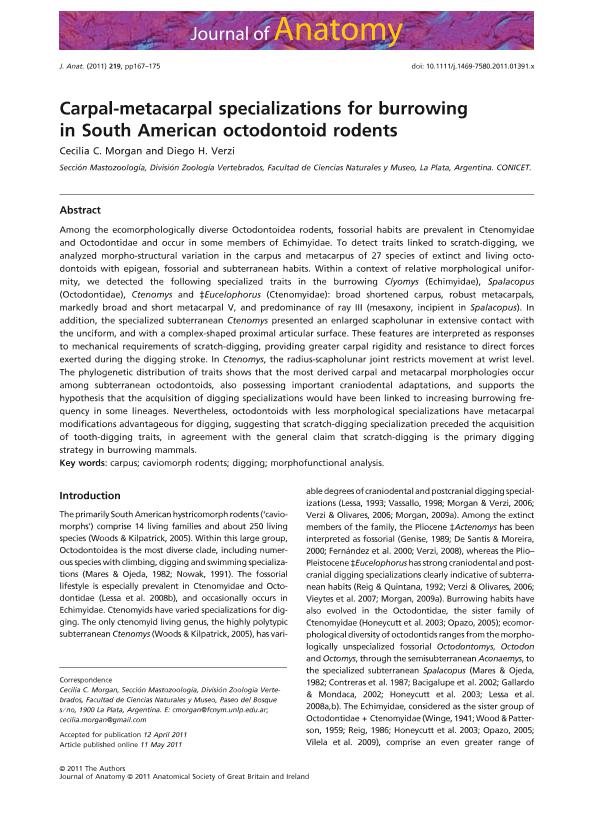Artículo
Carpal‐metacarpal specializations for burrowing in South American octodontoid rodents
Fecha de publicación:
08/2011
Editorial:
Wiley Blackwell Publishing, Inc
Revista:
Journal of Anatomy
ISSN:
0021-8782
Idioma:
Inglés
Tipo de recurso:
Artículo publicado
Clasificación temática:
Resumen
Among the ecomorphologically diverse Octodontoidea rodents, fossorial habits are prevalent in Ctenomyidae and Octodontidae and occur in some members of Echimyidae. To detect traits linked to scratch‐digging, we analyzed morpho‐structural variation in the carpus and metacarpus of 27 species of extinct and living octodontoids with epigean, fossorial and subterranean habits. Within a context of relative morphological uniformity, we detected the following specialized traits in the burrowing Clyomys (Echimyidae), Spalacopus (Octodontidae), Ctenomys and †Eucelophorus (Ctenomyidae): broad shortened carpus, robust metacarpals, markedly broad and short metacarpal V, and predominance of ray III (mesaxony, incipient in Spalacopus). In addition, the specialized subterranean Ctenomys presented an enlarged scapholunar in extensive contact with the unciform, and with a complex‐shaped proximal articular surface. These features are interpreted as responses to mechanical requirements of scratch‐digging, providing greater carpal rigidity and resistance to direct forces exerted during the digging stroke. In Ctenomys, the radius‐scapholunar joint restricts movement at wrist level. The phylogenetic distribution of traits shows that the most derived carpal and metacarpal morphologies occur among subterranean octodontoids, also possessing important craniodental adaptations, and supports the hypothesis that the acquisition of digging specializations would have been linked to increasing burrowing frequency in some lineages. Nevertheless, octodontoids with less morphological specializations have metacarpal modifications advantageous for digging, suggesting that scratch‐digging specialization preceded the acquisition of tooth‐digging traits, in agreement with the general claim that scratch‐digging is the primary digging strategy in burrowing mammals.
Palabras clave:
CARPUS
,
CAVIOMORPHS
,
DIGGING
,
MORPHOFUNCTIONAL ANALYSIS
Archivos asociados
Licencia
Identificadores
Colecciones
Articulos(CCT - LA PLATA)
Articulos de CTRO.CIENTIFICO TECNOL.CONICET - LA PLATA
Articulos de CTRO.CIENTIFICO TECNOL.CONICET - LA PLATA
Citación
Morgan, Cecilia Clara; Verzi, Diego Hector; Carpal‐metacarpal specializations for burrowing in South American octodontoid rodents; Wiley Blackwell Publishing, Inc; Journal of Anatomy; 219; 2; 8-2011; 167-175
Compartir
Altmétricas




